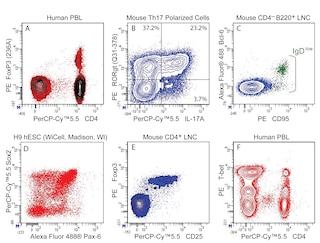Old Browser
Looks like you're visiting us from {countryName}.
Would you like to stay on the current country site or be switched to your country?


.png)

Multicolor flow cytometric analysis of FoxP3 expressed in resting human peripheral blood lymphocytes. Human peripheral blood mononuclear cells (PBMC) were stained with FITC Mouse Anti-Human CD4 (Cat. No. 566320) and BD Horizon™ BV421 Mouse Anti-Human CD25 (Cat. No. 562442) antibodies. The cells were fixed and permeabilized using the BD Pharmingen™ Transcription Factor Buffer Set (Cat. No. 562574/562725) followed by intracellular staining with BD Horizon™ R718 Mouse Anti-Human FoxP3 antibody (Cat No. 566935/566936/566937). The pseudocolor density plots showing the corelated expression of FoxP3 versus CD25 (Left Plot) or CD4 versus FoxP3 (Right Plot) were derived from gated events with the forward and side-light scatter characteristics of intact lymphocytes. Flow cytometry and data analysis were performed using a BD LSRFortessa™ Cell Analyzer System and FlowJo™ software.
.png)

BD Horizon™ R718 Mouse Anti-Human FoxP3
.png)
监管状态图例
未经BD明确书面授权,严禁使用未经许可的任何商品。
准备和存储
推荐的实验流程
BD™ CompBeads can be used as surrogates to assess fluorescence spillover (Compensation). When fluorochrome conjugated antibodies are bound to BD CompBeads, they have spectral properties very similar to cells. However, for some fluorochromes there can be small differences in spectral emissions compared to cells, resulting in spillover values that differ when compared to biological controls. It is strongly recommended that when using a reagent for the first time, users compare the spillover on cells and BD CompBead to ensure that BD CompBeads are appropriate for your specific cellular application.
商品通知
- This reagent has been pre-diluted for use at the recommended Volume per Test. We typically use 1 × 10^6 cells in a 100-µl experimental sample (a test).
- An isotype control should be used at the same concentration as the antibody of interest.
- Caution: Sodium azide yields highly toxic hydrazoic acid under acidic conditions. Dilute azide compounds in running water before discarding to avoid accumulation of potentially explosive deposits in plumbing.
- Alexa Fluor® is a registered trademark of Life Technologies Corporation.
- Please refer to http://regdocs.bd.com to access safety data sheets (SDS).
- Species cross-reactivity detected in product development may not have been confirmed on every format and/or application.
- Please refer to www.bdbiosciences.com/us/s/resources for technical protocols.
- This product is provided under an Agreement between BIOTIUM and BD Biosciences. This product, and only in the amount purchased by buyer, may be used solely for buyer’s own internal research, in a manner consistent with the accompanying product literature. No other right to use, sell or otherwise transfer (a) this product, or (b) its components is hereby granted expressly, by implication or by estoppel. This product is for research use only. Diagnostic uses require a separate license from Biotium, Inc. For information on purchasing a license to this product including for purposes other than research, contact Biotium, Inc., 3159 Corporate Place, Hayward, CA 94545, Tel: (510) 265-1027. Fax: (510) 265-1352. Email: btinfo@biotium.com.
配套商品



.png?imwidth=320)


The 259D/C7 monoclonal antibody specifically recognizes human Forkhead box protein P3 (FoxP3) that is also known as Scurfin. FoxP3 is encoded by FOXP3 (Forkhead box P3), likewise known as IPEX (Immune Dysregulation, Polyendocrinopathy, Enteropathy, X-Linked) and JM2, that belongs to the forkhead/winged-helix family of transcriptional regulators. FoxP3 is expressed in CD4+ regulatory T cells (Treg) and represents a specific marker for these cells. Flow cytometric analyses have shown that FoxP3 is expressed by the majority of CD4+CD25+high T cells in peripheral blood while less than half of the CD4+CD25+intermediate cell population are FoxP3 positive. Approximately 5-10% of peripheral CD4+ cells are CD4+CD25+ T regulatory cells. T regulatory cells are thought to play a critical role in the regulation of T cell-mediated immunity and to protect against autoimmunity by suppressing the proliferation and cytokine production of other T cells. In support of this hypothesis, it has been found that Foxp3 is mutated in Scurfy (sf) mice that have defective T cell tolerance leading to an X-linked lymphoproliferative disease. The 259D/C7 antibody recognizes all currently-identified isoforms of human FoxP3 and is crossreactive with FoxP3 from Cynomolgus, Rhesus and Baboon primates.
The antibody was conjugated to BD Horizon Red 718, which has been developed exclusively for BD Biosciences as a better alternative to Alexa Fluor® 700. BD Horizon Red 718 can be excited by the red laser (628 – 640 nm) and, with an Em Max around 718 nm, it can be detected using a 730/45 nm filter. Due to similar excitation and emission properties, we do not recommend using R718 in combination with APC-R700 or Alexa Fluor® 700.

研发参考 (4)
-
Brunkow ME, Jeffery EW, Hjerrild KA, et al. Disruption of a new forkhead/winged-helix protein, scurfin, results in the fatal lymphoproliferative disorder of the scurfy mouse. Nat Genet. 2001; 27(1):68-73. (Biology). 查看参考
-
Lauer FT, Denson JL, Beswick E, Burchiel SW. Intracellular Cytokine Detection by Flow Cytometry in Surface Marker-Defined Human Peripheral Blood Mononuclear T Cells.. Curr Protoc Toxicol. 2017; 73:18.19.1-18.19.14. (Clone-specific: Flow cytometry). 查看参考
-
Roncador G, Brown PJ, Maestre L, et al. Analysis of FOXP3 protein expression in human CD4+CD25+ regulatory T cells at the single-cell level. Eur J Immunol. 2005; 35(6):1681-1691. (Immunogen: Flow cytometry, Immunohistochemistry, Western blot). 查看参考
-
Wildin RS, Ramsdell F, Peake J, et al. X-linked neonatal diabetes mellitus, enteropathy and endocrinopathy syndrome is the human equivalent of mouse scurfy. Nat Genet. 2001; 27(1):18-20. (Biology). 查看参考
Please refer to Support Documents for Quality Certificates
Global - Refer to manufacturer's instructions for use and related User Manuals and Technical data sheets before using this products as described
Comparisons, where applicable, are made against older BD Technology, manual methods or are general performance claims. Comparisons are not made against non-BD technologies, unless otherwise noted.
For Research Use Only. Not for use in diagnostic or therapeutic procedures.
Report a Site Issue
This form is intended to help us improve our website experience. For other support, please visit our Contact Us page.